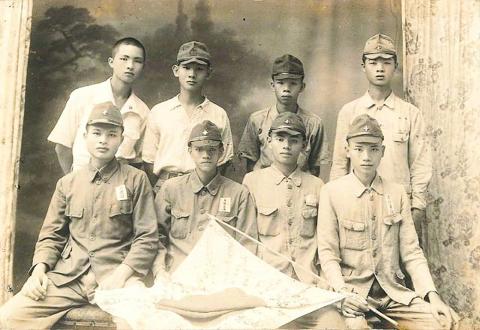Taiwan in Time: Feb. 8 to Feb. 14
If the Japanese hadn’t lost World War II, it is likely that Taipei Mayor Ko Wen-je’s (柯文哲) surname would be Aoyama. And former president Lee Teng-hui (李登輝) would still be officially known as Iwasato Masao.

Photo courtesy of Wikicommons
Historian Shih-shan Henry Tsai (蔡石山) writes in his book, Lee Teng-hui and Taiwan’s Quest for Identity, that Lee’s father was the first one in the family to “Japanize” his name to Iwasato Tatsuo when he served as a policeman.
After the Japanese colonial government announced their policy to allow and encourage Taiwanese to Japanize their names on Feb. 11, 1940 — which was the 2,600th anniversary of the founding of Japan — Lee and his older brother had their names changed too.
“Like other Taiwanese fathers who desired to improve their family’s social and economic conditions, [Lee] decided to take Japanese names for his entire family,” Tsai writes.
This name-change policy was part of the government’s push to Japanize their colonial subjects, a direct result of the country’s imperialist policy that came to a head with its invasion of China in 1937. The goal was to eradicate Taiwanese of their identity and transform them into full Japanese citizens, who, by extension, would be willing to die for the Japanese emperor in battle (about 30,000 Taiwanese died as Japanese soldiers during World War II).
While the name change was optional and was limited to families that were already speaking Japanese and deemed to be proper “imperial subjects,” other changes were mandatory such as the regulation of local performance arts such as puppetry, banning the teaching of Hoklo (also known as Taiwanese) in schools, forced conversion to Shintoism and worship and the abolishment of Chinese-language newspapers.
Historian Ho Feng-chiao (何鳳嬌) writes in an Academia Historica study that some Japanese living in Taiwan opposed the move as it would diminish their superior status and make it harder to distinguish the two groups, and as a result the name change became a policy of “encouragement” only.
Ho writes that people could pretty much choose their own new surname, but four types of surnames were banned: those relating to the Japanese imperial house, any belonging to famous Japanese historic figures, those referring to the original surname’s place of origin in China and “other improper names.”
There were a number of ways to adopt a surname, including breaking up the original surname’s Chinese character into two parts and adopting a Japanese pronunciation, using new Japanese characters to approximate the original surname’s Chinese pronunciation or adopting certain features of their environment such as rice fields, rivers and bridges.
Tsai explains how Lee became Iwasato in his book. Iwa in Japanese means rock, which Tsai says refers to the rocky terrain of Sanjhih (三芝), where the Lee clan resided. Sato is pronounced “li” in Chinese, so in a way the Lees still retained a trace of their original name.
Taiwanese were not enthusiastic about the policy, and despite numerous government incentives, by the end of 1941 only about 1 percent of the population made the change. Many who did were either prominent citizens or those who worked closely with the Japanese or in a Japanese institution, such as public servants and teachers. Like Lee’s father, many also hoped that the name change would provide better educational opportunities for their children.
By the end of 1943, only two percent had followed suit. As a result, the aforementioned restrictions were loosened in 1944, which is when Ko’s grandfather changed his name to Aoyama.
Ho writes that once the Japanese surrendered, many Taiwanese reverted to their old names even before the Chinese Nationalist Party (KMT) arrived to install an official reversal policy.
However, an unexpected result arose. Since all Japanese public and private property were to be confiscated by the new government, officials often couldn’t tell whether the property belonged to an actual Japanese or a Taiwanese using a Japanese name, leading to many land disputes in the early days of KMT rule.

It’s a good thing that 2025 is over. Yes, I fully expect we will look back on the year with nostalgia, once we have experienced this year and 2027. Traditionally at New Years much discourse is devoted to discussing what happened the previous year. Let’s have a look at what didn’t happen. Many bad things did not happen. The People’s Republic of China (PRC) did not attack Taiwan. We didn’t have a massive, destructive earthquake or drought. We didn’t have a major human pandemic. No widespread unemployment or other destructive social events. Nothing serious was done about Taiwan’s swelling birth rate catastrophe.

Words of the Year are not just interesting, they are telling. They are language and attitude barometers that measure what a country sees as important. The trending vocabulary around AI last year reveals a stark divergence in what each society notices and responds to the technological shift. For the Anglosphere it’s fatigue. For China it’s ambition. For Taiwan, it’s pragmatic vigilance. In Taiwan’s annual “representative character” vote, “recall” (罷) took the top spot with over 15,000 votes, followed closely by “scam” (詐). While “recall” speaks to the island’s partisan deadlock — a year defined by legislative recall campaigns and a public exhausted

In the 2010s, the Communist Party of China (CCP) began cracking down on Christian churches. Media reports said at the time that various versions of Protestant Christianity were likely the fastest growing religions in the People’s Republic of China (PRC). The crackdown was part of a campaign that in turn was part of a larger movement to bring religion under party control. For the Protestant churches, “the government’s aim has been to force all churches into the state-controlled organization,” according to a 2023 article in Christianity Today. That piece was centered on Wang Yi (王怡), the fiery, charismatic pastor of the

Hsu Pu-liao (許不了) never lived to see the premiere of his most successful film, The Clown and the Swan (小丑與天鵝, 1985). The movie, which starred Hsu, the “Taiwanese Charlie Chaplin,” outgrossed Jackie Chan’s Heart of Dragon (龍的心), earning NT$9.2 million at the local box office. Forty years after its premiere, the film has become the Taiwan Film and Audiovisual Institute’s (TFAI) 100th restoration. “It is the only one of Hsu’s films whose original negative survived,” says director Kevin Chu (朱延平), one of Taiwan’s most commercially successful